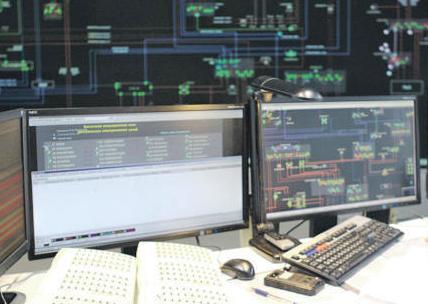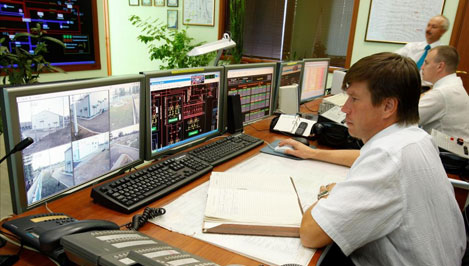Dispatch points in the power supply system
Dispatch in power supply and power consumption systems is a centralized system for managing power supply devices.
In enterprises, there are two types of organization for managing dispatchers.
1. Dispatch control is carried out by the Chief Energy Engineer department, while the functions of the Chief Dispatcher are performed by the Chief Energy Engineer or one of the specialists of the department. The functions of duty dispatchers are assigned to the duty engineers of the substation.
2. The department of the chief energy engineer has a dispatch office, which includes the chief dispatcher and duty dispatchers located at the dispatch station.

The dispatch center carries out operational management and control of the operation of all elements of the power supply system, management of duty personnel for the production of operational keys and admission to repair activities, management of emergency response in the power supply system, control over the load of individual lines and substations, control over modes of energy consumption in the workshops and the enterprise.
From the control center, centralized automated management of the entire power supply system of the enterprise is carried out on the basis of telemechanics and means of computerization.
In the dispatch center, the electrical load and voltage at various points of the enterprise's electrical network are monitored, switching is carried out in order to eliminate emergency modes, as well as bringing in a substation and line equipment for repair.
The control room includes rooms:
-
dispatcher's room with the location of the dispatcher's panel and the control panel — the dispatcher's workplace;
-
control room, where various equipment is located (power supplies, relay cabinets, telemechanical devices, etc.);
-
a workshop for minor repairs of equipment and a laboratory for its adjustment;
-
auxiliary premises (storage room, bathroom, room for repair teams).
The layout of the control room is carried out to ensure the convenience of installation and switching connections, monitoring of serviced equipment, access to all premises. In the control room there are control panels and consoles on which control devices, signaling and automatic devices and controls are installed.
By purpose, panels and consoles are divided into operational (monitoring and control) and auxiliary panels. A mnemonic diagram is placed on the control panel, which, using conditional graphic images of the elements of the power supply system, shows the technological process and represents an information model of the controlled object, process.
According to the degree of reliability of electricity, dispatch points are classified as 1st category users… Telemechanization devices installed in the control room allow obtaining the necessary information about the state of electrical equipment located at a considerable distance, about the parameters of the power supply system and the consumption of electrical energy. In this case, means of telemechanization are used, which include devices for telemetry, telesignaling and telecontrol.
In substations equipped with automation and telemechanization systems, local control of switches for their adjustment, the possibility of revision and repair of distribution equipment is provided.
Control room equipment is grounded in accordance with PUE.
According to the degree of fire danger, the premises of the control rooms are classified as category G, they must meet the first or second degree of fire resistance according to fire requirements. The premises are protected from the penetration of dust and gases. Rooms should have natural light. Working electrical lighting should be diffused, provided by fluorescent lamps, incandescent emergency lamps.

The automated system for managing power supply and energy consumption in the enterprise is aimed at trouble-free and continuous power supply, economic organization of modes and measurement of electricity consumption, compliance with schedules for electrical loads and planned prevention of electrical equipment, management of permits for operation of teams of electricians.
In large enterprises, dispatching is organized not only in the power supply and energy consumption systems of the enterprise, but also in all energy services as part of the department of the chief electrical engineer (heat supply and heating installations, water supply and sewage, gas supply).
In enterprise power systems, automated enterprise dispatch control systems (ASDU) equipped devices means of automation and telemechanization, provides:
-
centralization of control and management of power modes;
-
increasing the effectiveness of control over the operation of electrical devices and electrical networks and their management;
-
selection and establishment of optimal operating mode for equipment and networks;
-
increasing the reliability of electricity supply to consumers;
-
reduction of the number of accidents and their faster elimination;
-
reduction of staff on duty in electrical installations.
Operational control tasks solved by the automated control system are determined by the operating mode of the power supply system. In normal mode,
-
control and regulation of electricity supply and energy consumption, ensuring the necessary requirements for the quality of electricity and the reliability of its supply;
-
collection, processing and documentation of information on the operation of devices in power supply systems;
-
withdrawal of equipment for repair and its introduction from repair and from reserve.
In emergency mode, automatic devices of the first level (relay protection) are activated.
In this case, the operational dispatching staff performs the necessary shutdowns (switching) of power supply devices. In emergency mode, the task of restoring the normal power supply scheme to consumers, the indicated indicators of electricity quality, taking measures to eliminate the causes of the accident and repairing the damaged equipment is solved.
